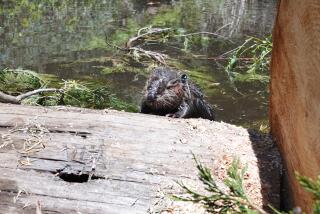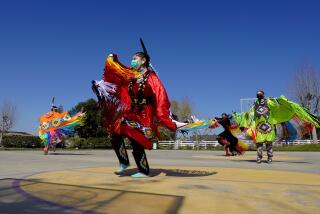Maidu Indian, 74, Is Last of Her Tribe’s Basket Makers : She’s Weaving Her Way Into History
- Share via
LAKE ALMANOR, Calif. — For centuries Maidu Indians of the northern Sierra Nevada were hunters of bear and deer and weavers of exquisite baskets. Museums in Butte, Lassen and Plumas counties, home of the mountain tribe, as well as many other museums have collections of baskets from the early 1800s.
Maidu basket weaving was an art handed down from grandmother to mother to daughter. Now that tradition is in danger of running out.
For years Lilly Baker, 74, a full-blooded Maidu who lives on the eastern shore of this large Plumas County lake, about 50 miles east of Red Bluff, has been the last of the Maidu basket weavers.
“My family was the last to make the baskets--Jenny Meadows, my great-grandmother; Kate McKinney, my grandmother, and Daisy Baker, my mother. Now me,” the silver-haired, unmarried woman said. “The other Maidus quit a long time ago. I have been alone at this since my mother died in her 80th year in 1964.”
Like Baker, her deceased sister and three brothers never married. She is the last of her line.
She was busy weaving bone-white willow withes as she talked, and she told of the many uses the Maidus had for the baskets--for gathering seeds, acorns, fruits and vegetables, and for serving as water bowls, cooking utensils, fish traps and cradle boards.
“Women weaved huge sacrificial baskets. My mother, grandmother and great-grandmother and their mothers and grandmothers before them would spend an entire year weaving one sacrifice basket,” she said. “That basket would be placed in a big bonfire at what the Maidus called the annual burning. The basket would be a sacrifice for a departed loved one.”
Other baskets were especially fashioned to be cut up in pieces and placed in a burial box with the departed relative “for the long journey.”
There are an estimated 650 Maidu Indians today. Only a handful are fullbloods like Baker. Most who call themselves Maidu are half-, quarter-, or one-eighth Indian.
“I never know what the design of the basket will be when I start. It just happens,” she said. “It is the Maidu in me coming through my fingers.”
The basket she was weaving showed red geese descending out of the sky and was fashioned from the redbud tree bark. Some of her designs depict bear eyes; bears are an integral part of Maidu culture. She gathers willow twigs along creek bottoms, and collects the redbud bark and the fern root in the forest. And Baker visits schools and tells of the Maidu ways and demonstrates her basket weaving.
Fearful that the Maidu art of basket weaving would be lost, the Plumas County Arts Commission applied for and received a $2,500 grant from the National Endowment of the Arts to record Baker’s process of creating Maidu baskets in slides, photographs and text.
4 Women Chosen
The money has also been used to teach others who could pass along the knowledge and techniques of the age-old craft. Four women were selected to understudy the last of the Maidu basket weavers at learning sessions last year. The women are Maidus Lucille Bone, 45, and Lorena Moore, 36, and non-Indians Linda Brennan, 45, and Sherry Morrison, 30.
Brennan is curator of the Plumas County Museum, which has more than 100 Maidu baskets in its collection, some from the 1850s. The museum is in Quincy, the county seat.
“Lilly passed along her basket making skills to us. Now it is up to us to keep it alive and teach others,” she said.
The photographic record of Baker’s gathering of the materials and weaving methods--500 slides and stills--was done by Sue Gutierrez, 42, of nearby Meadow Valley. The text was written by Jane Braxton Little, 42, a Quincy writer.
“I hope at least one of the women keeps it going,” Baker sighed. “I have taught a few classes in basket weaving in the past but no one picked it up as a steady thing. It would be sad for the centuries-old Maidu tradition to die with me.”
More to Read
Sign up for Essential California
The most important California stories and recommendations in your inbox every morning.
You may occasionally receive promotional content from the Los Angeles Times.













